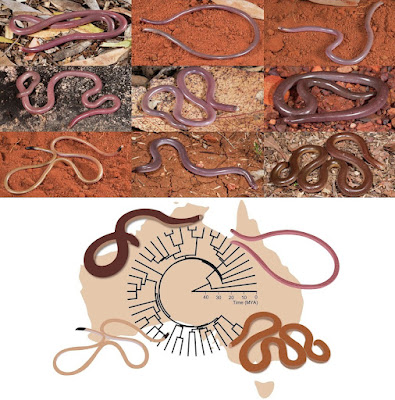 |
in Tiatragul, Brennan, Broady & Keogh, 2023. |
Highlights:
• Inferred a near-complete species-level phylogeny of Australian blind snakes from over 4900 genetic loci.
• Added seven previously unsampled Anilios species.
• Time-calibrated phylogeny reveals rapid early Miocene radiation of Anilios.
• Several paraphyletic groups require taxonomic revision.
....
Scolecophidians are believed to have originated in Gondwana 160 – 125 Ma (Vidal et al., 2010) and today comprises five extant families of superficially similar snakes including Anomalepididae (20 species in the Neotropics), Leptotyphlopidae (142 species in Africa, Arabia, and the New World), Gerrhopilidae (21 species in South Asia, the Malay Archipelago and Melanesia), Xenotyphlopidae (1 species in Madagascar) and Typhlopidae (275 species in the Neotropics, Africa, Madagascar, Southeastern Europe, Southern Asia, and Australia) (Midtgaard, 2021, Uetz et al., 2021). ....
The most taxonomically and geographically diverse family of Scolecophidia is the Typhlopidae, which comprises 19 genera. Among typhlopid genera, the Australo-Papuan genus Anilios represents the most species-rich radiation (Uetz et al., 2021) (see Fig. 1 for examples). Of the 48 currently recognised species of Anilios, 45 occur exclusively in Australia, A. erycinus is restricted to New Guinea and the Maluku Islands, and A. torresianus and A. leucoproctus are found in both Australia and southern parts of New Guinea (GBIF.Org, 2022). Although natural history accounts for Anilios blindsnakes are lacking, particularly at the species level, the Australian species are presumed to be fossorial and reported to feed primarily on pupae and larvae of ants and termites (Shine and Webb, 1990, Webb and Shine, 1993, Webb and Shine, 1992). In Australia, species are distributed across the mainland, with particularly high biodiversity north of 20°S — in the northern monsoonal tropical part of the continent (Marin et al., 2013b) (see Fig. S1 for map of species distributions).
...
Sarin Tiatragul, Ian G. Brennan, Elizabeth S. Broady and J. Scott Keogh. 2023. Australia’s Hidden Radiation: Phylogenomics Analysis reveals Rapid Miocene Radiation of Blindsnakes. Molecular Phylogenetics and Evolution. 185, 107812. DOI: 10.1016/j.ympev.2023.107812

